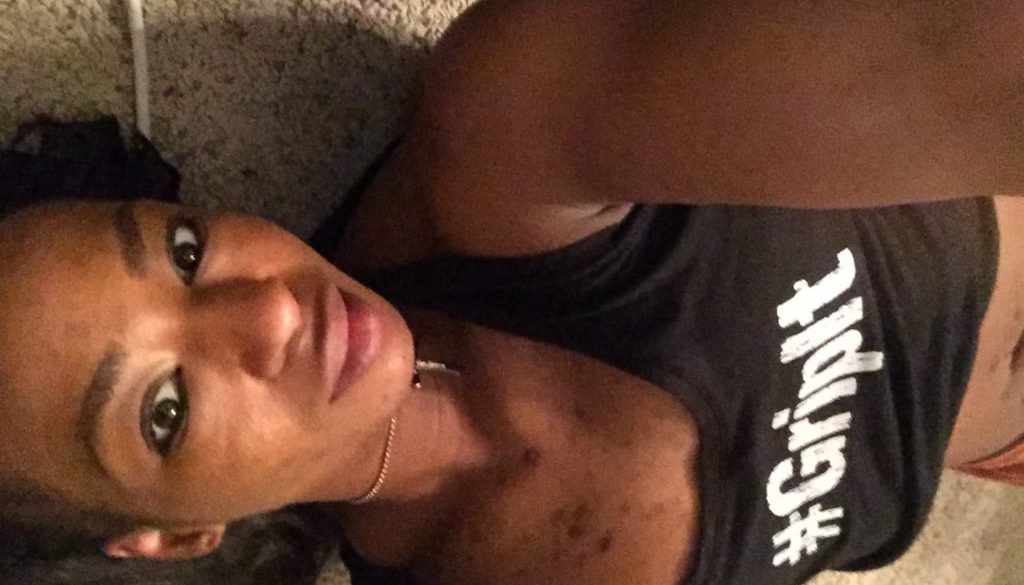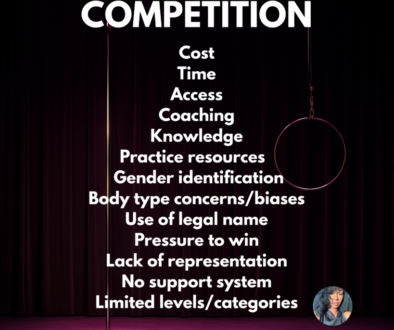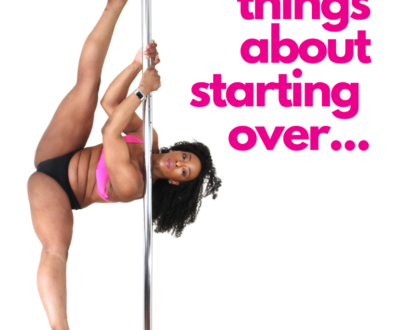Grip Tips
No matter if you are new to pole or a seasoned pro, somewhere along the way you’ve run into issues with grip. Grip and fear of slipping are a common theme amongst pole dancers, especially when it comes to competition. There are endless articles and shared posts about various grip aids: types, what to use, what works best, what to avoid, etc. Therefore, I am choosing not to address the topic of grip from those previously and well-covered perspectives. Rather, I want to share some insight and tips on things that I’ve discovered over the years, that hopefully will shed some light on the issue of grip and give you a good starting point for improving your grip issues. Overcoming grip and slip is a very personal journey, as there is no one-size-fits-all solution. I’ve included a few key tips to help you better understand the common causes of grip troubles, a quick into to grip aids and a few strategic and creative ways to solve them.
Understanding the source of your grip slip is key. I like to identify what it’s not, and use that to get closer to discovering what the problem is. There are both internal and external factors that can impact your grip-ability. And just because the popular Mighty Grip powder or Dry Hands that your pole peers use don’t seem to work for you, doesn’t mean that all hope is lost. Keep in mind that everyone’s body responds differently to the chemicals in grips. It just means that you have to dig a little deeper to find the right solution for you. The internal (or personal factors) that affect grip include your skin type (is your skin normal, dry, oily?), body temperature, grip strength, and fitness/endurance levels. Then there are also external or environmental factors like temperature, humidity, class size and pole diameter.
The biggest thing to understand is that some grip issues may be completely out of your hands. This can include things like Primary hyperhidrosis (consult your physician) and actual hand size. Primary hyperhidrosis is excessive sweating, not typically related to your body temperature or physical activity. Having small hands can affect the ability to grip a 45mm or 50mm pole and can make even the easiest moves more challenging. Good thing 38mm and 40mm poles are becoming more popular! So what can you do and where do you start? I’m glad you asked! Read on!
- Explore grips. If you haven’t explored grip and dry body options then start there so you can get educated on grip and test them out. There are lots of different types of grips, each with a different purpose and each can respond to skin types differently. Within the world of grips, there’s a variety of options, and each carries a different purpose. Some grips are designed to dry your skin, while some are slightly tacky, others are super sticky and finally, you have some that are antiperspirants. You’ll also find that some grips work on your hands and others are better used on various parts of the body. A few quick examples include: Antiperspirant grips such as Tite Grip can combat perspiration, sticky grips such as Firm Grip can offer a ruthless stick, iTac can be great for knee and elbow pits, but not so friendly on the hands. For more details, check out Aerial Amy’s grip aids post which explores more grip aids and offers some helpful insight.
- Apply Correctly! Not all grips are made equal and each have their own best practices. Make sure you are aware of the application procedures and you follow the recommended steps. For example, Might Grip powder is heat activated. This does not mean that a warm body will activate the grip, what their directions actually require, is FRICTION. It is Friction activated, so you really have to rub rub rub those hands together (almost like you’re trying to start a fire) and that is what makes the magic happen. Other grips like Dry Body wipes require you to shower first, some do require clean, freshly washed skin. So be sure to read the instructions on the labels.
- Explore grip alternatives. For some, solution grip aids such powders, liquids, rosin, sprays, etc., may not be an option or just might not work. In this case, try looking into alternatives such as glove, tack anklets and knee-pads with tack. This is also ideal for those who work with their hands and need to protect them from the callousness of pole such as massage therapists or doctors, who need soft hands.
- Warmup. Make sure that you are always properly and fully armed up. A warm body will always be grippier than a cold body. Getting your heart rate and body temp up will provide a natural stick which goes a long way. You’ll also find that your body temp can also affect the way grips work once applied.
- Respect your level. When it comes to routine building, select tricks that work with your current body type and grip type. This will change as you progress in your pole career, but for the time being, stick with what works best for the you that you are now. Especially when it comes choreographing routines for performances and competition. For example, if elbow holds are not your strong suit, then don’t try to force one into your routine…sliding out of it may be more of an issue with upper body engagement and being able to manipulate your weight distribution than it is with actually grip issues. So play it safe and save it for a later performance.
- Routine sequencing. Order matters! Put your more difficult moves at the beginning of your routine when your hands are most dry, freshly gripped up and when you’re less sweaty and your energy levels are still high. You start at 100% and every move from there drains you, so sequence accordingly.
- Personal Sequencing. Learn how to sequence in ways that work for your body and grip ability. Some combos may have to be remixed for successful execution. For example, maybe you envision a pole climb to a sit and then into a jasmine, but during execution, you end up sliding down the pole not able to nail your jasmine. On the other hand, your jasmine from a floor cupid is strong and steady. Go the route of least resistance. Execute your jasmine from the floor cupid and then maybe see if you can pull up into a pole sit from there.
- Personal Fitness + Endurance. One thing I found true to my personal journey is that sometimes the sweaty factor is caused by fitness level and endurance. These go hand-in-hand with your pole fitness journey. Routinely working on fitness and endurance, through cross-training and conditioning, will improve your ability to grip the pole in various moves, improve strength and give you the energy to go harder, longer. If you’ve ever taken a class with me, then you know I’m BIG on this. My students do a LOT of conditioning, so we can make sure that their bodies are working with them and not against them.
- Core, core and MORE CORE. If you are not utilizing your core during pole then your shoulders are having to take up the slack and take on more stress…which in turn can be the source of grip issues. Core warm-ups and core conditioning are vital. Another fun part of taking class with me! 😉
- Building Grip Strength. Improving grip strength in the hand can help, so make sure that you working to build a more powerful hand grip. There are a variety of hand grip strengtheners and finger strengtheners that you can invest in.
- Mask it. This specifically applies to sweat attacks that catch you off guard during a performance, or if you’re in a bind and need a somewhat “quick fix”. Let’s face it, sometimes things just catch us off guard or don’t go our way. In that case, sometimes, you just have to get creative and learn how to hide grip on your body or casually wipe your hands on your clothing to reduce sweat. A few ways you can mask a quick hand dry are: tugging on your clothes, crossing the arms across the chest (self-hug) and wiping them on your shirt as you uncross, a gentle squeeze of the buttocks. Just make sure that it fits into the theme of your routine and your music and also that the outfit you’re wearing will work with your plan. Props that you can wipe your hands off on or choreo where you can wipe your hands on your clothing
- Costume selection. There are three key things I like to consider here (other than picking a costume that fits your theme/character. The first is anchor points: make sure that you know which body parts need to be free and clear of fabric so that you can grip the pole. The second is airflow to overheated areas: if your neck sweats then keep your neck clear of hair and fabric so it can breathe. The third thing is: covering areas that sweat with fabric…as long as they aren’t a required anchor point or a cause of overheating. For example, if your armpits sweat and you don’t need a pit grip for any moves, then find a fashionable top with short sleeves that can soak up that sweat so that it doesn’t travel to other parts of the body inhibiting moves. A personal example, my forearms sweat like crazy. I’ve found that wrist bands can help with traveling sweat, so costumes where my armpits and sides are revealed but my forearms are covered are ideal.
- Hair styling. Styles such as hair up in a ponytail/bun or in a side ponytail will allow the neck to breath and help keep the body remain a little cooler. And speaking of hair, keep your hands out of your hair so you don’t transfer hairspray, gel or other hair product to your hands.
- Towel selection. This is minor, but I’ve found that it does matter. Not all towels are absorbent and wipe down the poles the same. I’ve found that some types work better than others. Microfiber towels clean and dry whereas others just seem to smear the sweat/moisture more.
- Talk to your doctor. If all else fails, seek medical attention from your doctor to check for any sort of conditions (or side effects to current medications) that can cause excessive sweating, such as Primary hyperhidrosis – a condition where you just sweat excessively, typically on the palms of the hands, soles of the feet, and armpits.
Side note for those on the competition circuit: I often hear talk about how “if only they [the competition] would let us put grip on the pole then I could grip and execute my routine successfully”. Newsflash, this is absolutely NOT the solution. Sorry! Although I too will apply grip on poles in class from time-to-time, I am actually happy that this practice is not allowed at most competitions. I realize that there are many people that will disagree with me and that’s okay, we’re all entitled to our opinions.
Here’s where I feel we need to step back and look at the bigger picture. Individually, we’re all focused on what’s best for “ME” to help “ME” grip and be most successful at competition. The competition organizer’s job is to do whats best for ALL of the competitors as a whole…and this is the perspective I choose to share from. It makes a tougher job for the pole cleaners to clean and takes longer between each performer, which ultimately can throw the schedule off. Additionally, the guarantee that each pole gets completely clean and de-gooed also goes down, which could affect you negatively, as the more grip build-up on a pole can change the consistency of the poles finish to the touch. What you feel can help your chances can hurt another person’s chances and vice versa. And best believe, if you even thought that a previous performer’s grip affected your performance, you’d be extremely vocal about it – and with good reason.




